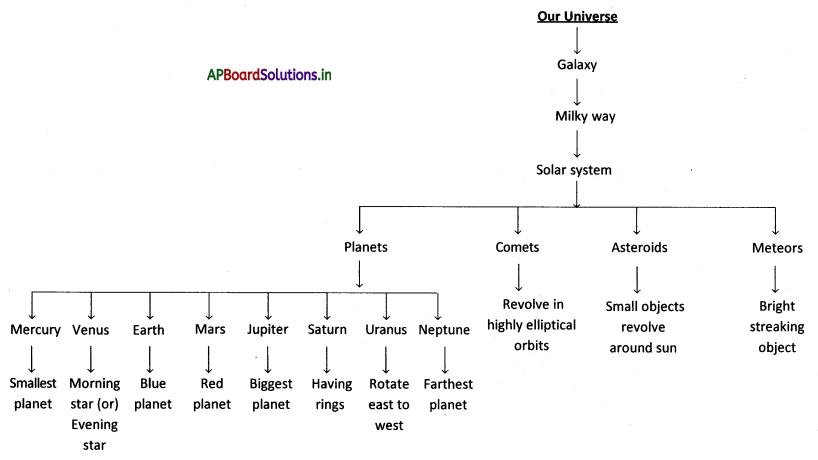Students can go through AP State Board 8th Class Physical Science Notes Chapter 12 Stars and the Solar System to understand and remember the concept easily.
AP State Board Syllabus 8th Class Physical Science Notes Chapter 12 Stars and the Solar System
→ The shortest shadow cast by a vertical object on the ground always falls in the north-south direction.
→ The shortest shadow of an object occurs at local noon.
→ The time duration for the appearance of the sun and moon after the completion of a cycle is different.
→ Changes in the appearance of the moon are called phases of the moon.
→ On the new moon day, the sun and moon are on the same side of the earth.
→ On the full moon day, the sun and moon are on either side of the earth.
→ Moon has no atmosphere as we have on the earth.
→ The pole star is situated in the direction of the earth’s axis and hence it appears as not moving.
→ There are eight planets in our solar system.
→ Among the eight planets of the solar system, the earth is the only planet that supports life.
![]()
→ A large number of objects that revolve around the sun between the orbits of Mars and Jupiter are asteroids.
→ The length of the tail of the comet grows in size as it approaches the sun.
→ A meteor is usually a small object that occasionally enters the earth’s atmosphere.
→ A body that reaches the earth is called a meteorite.
→ Aryabhatta was the first Indian artificial satellite.
→ Forecasting weather, transmitting television and radio signals, telecommunication, remote sensing are the practical applications of artificial satellites.
→ Celestial bodies: Objects present ¡n sky or outer space.
→ Local noon: The time when the shortest shadow occurs is called the local noontime at that place.
→ Sundial: A clock based on shadows of an object due to sunlight.
→ Dakshinoyanam: When the sun looks like traveling south of the sky, it ¡s called the Dakshinayanam.
→ Uttarayanam: When the sun looks like traveling towards the north of the sky is called the Uttarayanam.
→ Phases of the: The shape of the moon changes night after night. These moon changes in its appearance are called the phases of the moon.
→ Constellations: Group of stars having some shapes of animals or human beings is called constellations.
![]()
→ Galaxy: A group of stars that contain millions of stars is called galaxies.
→ Pole star: The star in the sky which appears fixed at one point.
→ Solar system: The sun and the celestial bodies which revolve around it form the solar system.
→ Planets: The planets look like stars but they do riot have the light of their own.
→ Satellites: The bodies revolving:.around around patients are called s9tllites.
→ Artificial satellites: Man-made satellites revolving around the earth are called artificial satellites
→ Asteroids: A large number of objects that revolve around the sun between the orbits of Mars and Jupiter ore asteroids
→ Comets: The celestial objects which revolve around the sun ¡n highly elliptical orbits.
→ Meteors: Meteors are usually small objects that occasionally enter the earth s atmosphere.
![]()
→ Meteorite: A body that reaches the earth is called a meteorite.

→ Johannes Kepler (1571 – 1630):
- Johannes Kepler was a German mathematician, astronomer, and astrologer.
- A key figure in the 17th-century scientific revolution, he is best known for his eponymous of planetary motion.
- His laws support the Heliocentric theory.